Director of the United States Marshals Service
The director of the United States Marshals Service, abbreviated USMS director, is the head and chief executive of the United States Marshals Service (USMS).[2] The director oversees and manages the operations of the Marshals Service and directly supervises the various United States marshals, which serve as the chiefs of the USMS within a federal judicial district.[3][4][5] The director was originally referred to as "Chief United States Marshall" from 1957 to 1970.
| Director of the United States Marshals Service | |
|---|---|
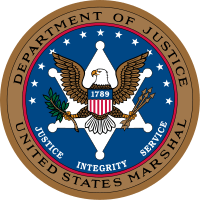 Seal of the Marshals Service | |
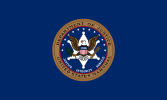 Flag of the Marshals Service | |
| United States Marshals Service | |
| Style | Director |
| Status | Chief executive |
| Reports to | United States Attorney General United States Deputy Attorney General |
| Seat | Crystal City, Arlington, Virginia |
| Appointer | The President with Senate advice and consent |
| Term length | No fixed term |
| Constituting instrument | 28 U.S.C. § 561 |
| Formation | December 20, 1957 |
| First holder | Clive W. Palmer |
| Deputy | Deputy Director |
| Salary | Executive Schedule, level IV[1] |
| Website | www.usmarshals.gov |
The director of the Marshals Service is appointer by the president of the United States, with the advice and consent of the United States Senate. The director reports to the United States Attorney General through the United States Deputy Attorney General.[6]
Powers and duties
The powers and duties of the director are established by chapter 37, part II, title 28 of the code of laws of the United States.
Section 561
Paragraph a):[7]
There is hereby established a United States Marshals Service as a bureau within the Department of Justice under the authority and direction of the Attorney General. There shall be at the head of the United States Marshals Service (hereafter in this chapter referred to as the “Service”) a Director who shall be appointed by the President, by and with the advice and consent of the Senate.
Paragraph b):
The Director of the United States Marshals Service (hereafter in this chapter referred to as the “Director”) shall, in addition to the powers and duties set forth in this chapter, exercise such other functions as may be delegated by the Attorney General.
Paragraph c):
The President shall appoint, by and with the advice and consent of the Senate, a United States marshal for each judicial district of the United States and for the Superior Court of the District of Columbia, except that any marshal appointed for the Northern Mariana Islands may at the same time serve as marshal in another judicial district. Each United States marshal shall be an official of the Service and shall serve under the direction of the Director.
Paragraph e):
The Director shall designate places within a judicial district for the official station and offices of each marshal. Each marshal shall reside within the district for which such marshal is appointed, except that—
- (1) the marshal for the District of Columbia, for the Superior Court of the District of Columbia, and for the Southern District of New York may reside within 20 miles of the district for which the marshal is appointed; and
- (2) any marshal appointed for the Northern Mariana Islands who at the same time is serving as marshal in another district may reside in such other district.
Paragraph f):
The Director is authorized to appoint and fix the compensation of such employees as are necessary to carry out the powers and duties of the Service and may designate such employees as law enforcement officers in accordance with such policies and procedures as the Director shall establish pursuant to the applicable provisions of title 5 and regulations issued thereunder.
Paragraph g):
The Director shall supervise and direct the United States Marshals Service in the performance of its duties.
Paragraph h):
The Director may administer oaths and may take affirmations of officials and employees of the Service, but shall not demand or accept any fee or compensation therefor.
Section 563
Paragraph a):[8]
The Director and each United States marshal and law enforcement officer of the Service, before taking office, shall take an oath or affirmation to faithfully execute the duties of that office.
Section 564
Paragraph a):[9]
United States marshals, deputy marshals and such other officials of the Service as may be designated by the Director, in executing the laws of the United States within a State, may exercise the same powers which a sheriff of the State may exercise in executing the laws thereof.
Section 565
Paragraph a):[10]
The Director is authorized to use funds appropriated for the Service to make payments for expenses incurred pursuant to personal services contracts and cooperative agreements, authorized by the Attorney General, for security guards and for the service of summons on complaints, subpoenas, and notices in lieu of services by United States marshals and deputy marshals.
Paragraph d):
Each United States marshal, deputy marshal, and any other official of the Service as may be designated by the Director may carry firearms and make arrests without warrant for any offense against the United States committed in his or her presence, or for any felony cognizable under the laws of the United States if he or she has reasonable grounds to believe that the person to be arrested has committed or is committing such felony.
Paragraph f):
In accordance with procedures established by the Director, and except for public money deposited under section 2041 of this title, each United States marshal shall deposit public moneys that the marshal collects into the Treasury, subject to disbursement by the marshal. At the end of each accounting period, the earned part of public moneys accruing to the United States shall be deposited in the Treasury to the credit of the appropriate receipt accounts.
Paragraph i):
The Director of the United States Marshals Service shall consult with the Judicial Conference of the United States on a continuing basis regarding the security requirements for the judicial branch of the United States Government, to ensure that the views of the Judicial Conference regarding the security requirements for the judicial branch of the Federal Government are taken into account when determining staffing levels, setting priorities for programs regarding judicial security, and allocating judicial security resources. In this paragraph, the term “judicial security” includes the security of buildings housing the judiciary, the personal security of judicial officers, the assessment of threats made to judicial officers, and the protection of all other judicial personnel. The United States Marshals Service retains final authority regarding security requirements for the judicial branch of the Federal Government.
List of officeholders
| Nr. | Portrait | Name[11] | Entered office | Left office[lower-alpha 1] |
|---|---|---|---|---|
| Chief United States Marshals (1957–1970) | ||||
| 1 | Clive W. Palmer[lower-alpha 2] | December 20, 1957 | June 21, 1962 | |
| 2 | 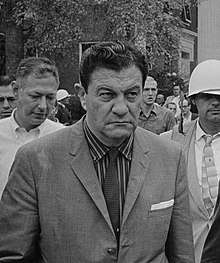 |
James J. P. McShane[lower-alpha 3] | June 21, 1962 | March 5, 1969 |
| 3 | Carl Turner[lower-alpha 4] | March 5, 1969 | January 16, 1970 | |
| Directors of the Marshals Service (1970–present) | ||||
| 1 | Wayne B. Colburn | January 16, 1970 | May 23, 1976 | |
| 2 | William E. Hall | May 23, 1976 | October 23, 1983 | |
| 3 | Stanley E. Morris | October 23, 1983 | November 6, 1989 | |
| 4 | Kevin Michael Moore | November 6, 1989 | February 24, 1992 | |
| 5 | Henry E. Hudson | February 24, 1992 | August 12, 1992 | |
| August 12, 1992 | October 17, 1993 | |||
| – | John J. Twomey | October 17, 1993 | November 18, 1993 | |
| 6 | Eduardo Gonzalez | November 18, 1993 | June 21, 1999 | |
| – | George Ray Havens | June 21, 1999 | November 17, 1999 | |
| 7 | John W. Marshall | November 17, 1999 | January 21, 2001 | |
| – | Louie McKinney | January 21, 2001 | October 30, 2001 | |
| 8 | Benigno G. Reyna | October 30, 2001 | August 1, 2005 | |
| 9 | 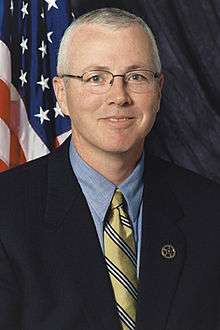 |
John F. Clark | August 1, 2005 | March 17, 2006 |
| March 17, 2006 | December 31, 2010 | |||
| 10 | Stacia A. Hylton | December 31, 2010 | July 26, 2015 | |
| – | David Harlow | July 26, 2015 | January 4, 2018 | |
| – | David Anderson[lower-alpha 5] | January 4, 2018 | March 29, 2019 | |
| 11 | 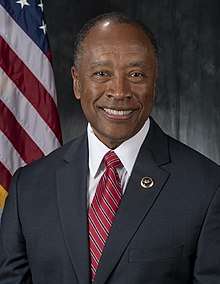 |
Donald W. Washington | March 29, 2019 | Present |
References
- "5 U.S. Code § 5315. Positions at level IV". www.law.cornell.edu. Retrieved 2020-03-04.
- "28 U.S. Code § 561. United States Marshals Service". www.law.cornell.edu. Retrieved 2020-03-04.
...There shall be at the head of the United States Marshals Service (hereafter in this chapter referred to as the “Service”) a Director...
- "28 U.S. Code § 561. United States Marshals Service". www.law.cornell.edu. Retrieved 2020-03-04.
(g) The Director shall supervise and direct the United States Marshals Service in the performance of its duties.
- "28 U.S. Code § 561. United States Marshals Service". www.law.cornell.edu. Retrieved 2020-03-04.
...Each United States marshal shall be an official of the Service and shall serve under the direction of the Director.
- "Donald W. Washington – Director". www.usmarshals.gov. Retrieved 2020-03-04.
...Director Washington directs a force of more than 5,000 operational and administrative employees spanning 94 districts...
- "Biography of Donald W. Washington". www.usmarshals.gov. Retrieved 2020-03-04.
- "28 U.S. Code § 561. United States Marshals Service". www.law.cornell.edu. Retrieved 2020-03-04.
- "28 U.S. Code § 563. United States Marshals Service". www.law.cornell.edu. Retrieved 2020-03-04.
- "28 U.S. Code § 564. United States Marshals Service". www.law.cornell.edu. Retrieved 2020-03-04.
- "28 U.S. Code § 565. United States Marshals Service". www.law.cornell.edu. Retrieved 2020-03-04.
- "History - List of USMS Directors and Predecessors". www.usmarshals.gov. Retrieved 2020-02-28.
Notes
- Only the date of appointment has been officially documented and displayed by the USMS; vacancies (as a result of death for example) thus may render the date a director left office incorrect.
- Full title was: Head (Chief), Executive Office for United States Marshals
- Full title was: Head (Chief), Executive Office for United States Marshals
- Full title was: Chief, Executive Office for United States Marshals
- Full title was: Acting Deputy Director